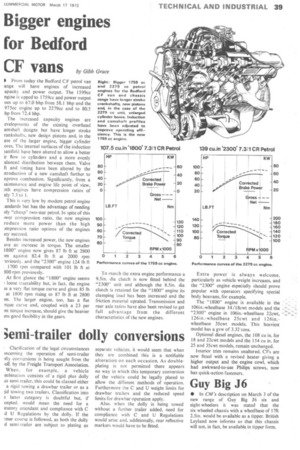Bigger engines for Bedford
Page 41

If you've noticed an error in this article please click here to report it so we can fix it.
CFvans by Gxbb Grace
From today the Bedford CF petrol van ange will have engines of increased apacity and power output. The 1599cc ngine is upped to 1759ce and power output ,oes up to 67.0 bhp from 58.1 bhp and the 975cc engine up to 2279cc and to 80.5 bp from 72.4 bhp.
The increased capacity engines are eveloprnents of the existing • overhead amshaft designs but have longer stroke rankshafts, new design pistons and, in the ase of the larger engine, bigger cylinder ores. The internal surfaces of the induction tanifold have been altered to allow a better ir flow to cylinders and a more evenly alanced distribution between them. Valve ft and timing have been altered by the ttroduction of a new camshaft further to nprove combustion. Significantly, from a taintenance and engine life point of view, oth engines have compression ratios of nly 7.3 to I.
This is very low by modern petrol engine :andards but has the advantage of needing nly "cheap" two-star petrol. In spite of this Iwer compression ratio, the new engines roduce more power than the high )mpression ratio options of the engines ley succeed.
Besides increased power, the new engines ave an increase in torque. The smaller 1800" engine now gives 87 lb ft at 2800 against 82.4 lb ft at 2000 rpm reviously, and the "2300" engine 124 lb ft : 1700 rpm compared with 101 lb ft at 300 rpm previously.
At first glance the "1800" engine seems loose tractability but, in fact, the engine is a very flat torque curve and gives 85 lb at 1800 rpm rising to 87 lb ft at 2800 nn. The larger engine, too, has a flat ,rque curve and, coupled with a 23 per :nt torque increase, should give the heavier ins good flexibility in the gears.
To match the extra engine performance a 9.5in, dia clutch is now fitted behind the "2300" unit and although the 8.5in. dia clutch is retained for the "1800" engine its clamping load has been increased and the friction material uprated. Transmission and rear axle ratios have also been revised to get full advantage from the different characteristics of the new engines. Extra power is always welcome, particularly as vehicle weight increases, and the "2300" engine especially should prove popular with operators specifying special body boxvans, for example.
The "1800" engine is available in the 106in.-wheelbase 14718cwt models and the "2300" engine in 106in.-wheelbase 22cwt, 126in.-wheelbase 25cwt and 126in.wheelbase 35cwt models. This heaviest model has a gvw of 3.32 tons.
Optional diesel engines, the 108 cu in. for 18 and 22cwt models and the 154 cu in. for 25 and 35cw-t models, remain unchanged.
Interior trim remains unaltered. CFs are now fitted with a revised heater giving a higher output and the engine cowl, which had awkward-to-use Philips screws, now has quick-action fasteners.










































































































